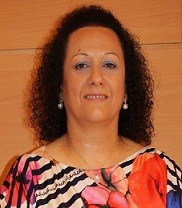
Yolanda Muñoz Gómez is General-Secretary of the Regional Ministry for Development and Infrastructures in the Region of Murcia
Graduated in Law, specialised in EU law, Construction Law and Administrative Law, Yolanda was a Legal Advisor for the Urban Planning Department at Las Torres de Cotillas Municipality (1998-2008). At that Council, she was also Town Councillor for Urban Planning, Architecture, Housing, Transport, Public Works and Municipal Services (2003-2011). From April 2014, she works as General-Secretary of the Regional Ministry for Development and Infrastructures in the Region of Murcia.
Could you describe in a few words the innovative approach applied to the buildings renovation of the Region of Murcia? What kind of buildings were renovated? What was the result?
The Government of the Region of Murcia, through the Regional Ministry of Development and Infrastructure, is carrying out the so-called Housing Plan 2013-2016. This plan, executed within the framework of the Royal Decree 233/2013, is aimed at developing the Program for the promotion of building rehabilitation. Through this Program, the Ministry of Development offers an Aid Plan for building rehabilitation.
The main objective of this plan is to promote new strategies for urban rehabilitation, regeneration and renovation that will allow urban centers to become more valuable, but also to improve tourist attractions, to generate employment and to re-launch the construction sector. Likewise, promoting energy savings and boosting the materials industry, it is a decisive commitment to the energy efficiency of our buildings.
This aid is co-financed through a multi-level structure, which includes the European Union (ERDF), the National Ministry of Development and our own Ministry, which contributes 20% to the funds. Before applying, every building is required to pass an inspection test that guarantees that it meets a minimum quality check. As a result, the competent technician prepares the Building Evaluation Report, an essential requirement to acquire the status of beneficiary of the grant. In this way, the administration can assure an efficient use of public funds.
The buildings granted are residential, including commercial premises. Intensity of the grant for energy rehabilitation depends on the level of improvement in energy efficiency achieved, which should be a minimum reduction of 30% of the demand of energy, and a maximum of a 50%.
To sum up, during the period 2013-2016, this Program has carried out the rehabilitation of 144 buildings (2.929 houses), which has contributed to the generation of 512 new employments. Investments accomplished in building rehabilitation are worth 9.141.945 €. These interventions have been boosted by 4.309.978 € grants awarded (47% total investment). Main actions were the improvement of accessibility and conservation of the buildings.
Regarding the geographic distribution of the investments, 40,97% of the actions have been carried out in the municipality of Murcia, 21,53% in Cartagena, followed by Cieza (8.33%), Águilas (5.56%), Alcantarilla (5,56%), Torre Pacheco (3.8%) and Caravaca (3.47%).
Why did you decide to use this kind of financing tool in your region for building rehabilitation?
The economic situation of Spanish families (and the Region of Murcia) did not make it advisable to base grants on financing instruments. In most cases, families in need of this type of aid did not have easy access to credit and the plan could have been a failure under such conditions. In order to support the development of residential rehabilitation projects, we opted for direct grants, based on previously developed projects that may offer guarantees endorsed by the competent technicians.
Finally, the development of the Plan proved us right and results speak for themselves: 2.929 houses have been rehabilitated under such unfavourable economic situation for all citizens.
Once the Plan is being implemented, how useful do you find the innovative approach that you applied? What advantages did you appreciate?
It is convenient and necessary to establish minimum criteria of quality for the buildings so that public money is well used and the investments have a minimum durability.
On the other hand, the detection of specially deteriorated areas, which we have called ARRU (Regeneration and Urban Renewal Areas), has allowed us to sign agreements with some municipalities in the Region in order to stimulate investment in the rehabilitation of buildings, allocating a specific budget line for redevelopment of the area. This instrument has been playing a key role when disseminating and spreading the plan, reaching as many citizens as possible.
What were the biggest problems in the implementation of the Plan in the Region of Murcia?
Without hazard of a doubt, economic difficulties that are going through (or were going through at that time) the families in our region, have greatly restricted their co-financing capacity. Thus, even having shown their interest in energy rehabilitation schemes, many of them could not take the step forward to make their houses more efficient.
What is more, not only did budget adjustments in national and regional administrations meant a limitation on the available budget, but also an opportunity to make a highly efficient use of public resources made available to the citizens
How do you evaluate the whole experience?
Overall, it has been a very positive experience. Being the first plan that included energetic rehabilitation of buildings, the efforts developed in dissemination actions have been extraordinary. Hence, despite the novelty of the initiative and the adverse conjuncture, a significant number of actions have been implemented. Said that, I would like to point out that now the way is well smoothed. The message has got through. Citizens are now aware of the benefits of energy rehabilitation of buildings. And we are motivated enough to keep on this track with the upcoming plans.


 Print HTML
Print HTML